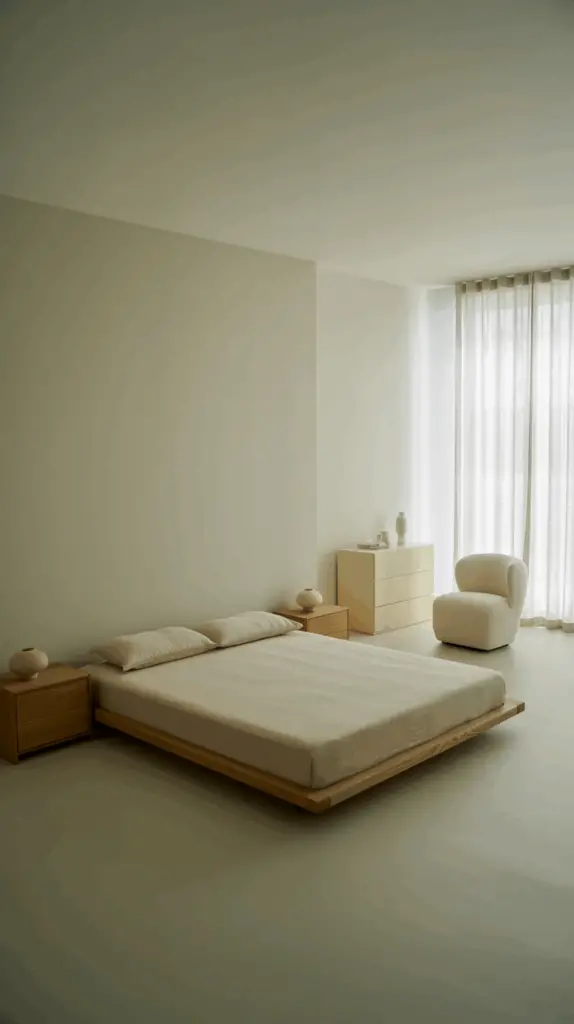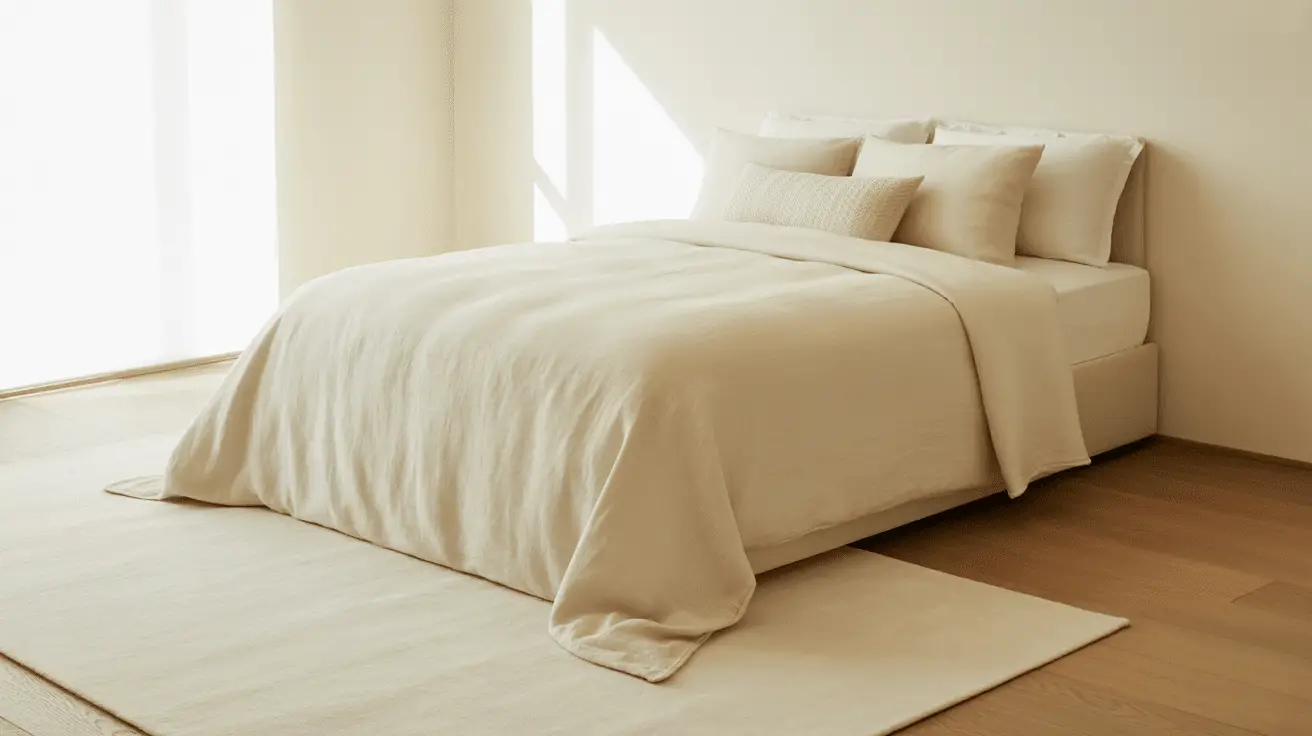Elegant Cream and White Bedroom Inspiration for Minimalist Home Lovers
Table of Contents
Introduction
Can a room be both luxuriously calming and strikingly simple? Absolutely—and the answer often lies in a beautifully executed cream and white color palette. For lovers of minimalist home design, these two tones offer a visual serenity that is hard to match. With their clean lines, soft edges, and sophisticated neutrality, cream and white bedrooms embody the essence of peaceful minimalism.
In fact, a 2023 interior design report by Houzz noted that minimalist styles are not just enduring—they’re evolving. Today’s minimalist bedrooms aren’t cold or clinical. Instead, they embrace texture, tone, and subtle layers that make the space feel inviting rather than stark. And when it comes to color, cream and white are at the heart of this soft minimalism movement.
This article explores cream and white bedroom inspiration that strikes a delicate balance between understated elegance and everyday comfort. From curated furnishings and cozy textures to lighting and storage ideas, you’ll find everything you need to transform your space into a restful, clutter-free sanctuary that’s both minimal and memorable. Whether you’re revamping a master suite or designing a serene guest room, these ideas will guide you to a harmonious aesthetic built around simplicity and warmth.
Build the foundation with a balanced cream and white color palette
A minimalist bedroom thrives on visual clarity—and nothing supports that better than a thoughtfully balanced cream and white palette. While both shades are considered neutrals, they offer subtle differences in tone and warmth that can greatly affect the mood of a space. When layered correctly, cream softens the crispness of white, creating a tranquil, cohesive look that feels organic and fresh.
Start with your primary surface areas: walls, bedding, and flooring. A white-painted wall offers a blank canvas that reflects natural light, while cream bedding or area rugs bring a gentle contrast that warms the space. For those who prefer a cozier envelope, consider reversing the formula with cream-toned walls and bright white accents through decor or linens.
Layering is key in achieving depth without color. Incorporate multiple shades of cream—from ivory and vanilla to buttermilk and oat—and offset them with stark or soft whites depending on your preference for contrast. Keep undertones consistent to avoid clashing (warm creams with warm whites, cool creams with cooler whites).
Cream and White Color Pairing Chart
| White Base | Complementary Cream Shade | Effect on Space | Best Used For |
| Pure White | Soft Vanilla | Clean and inviting | Walls with warm bedding |
| Antique White | Pale Oat | Classic and cozy | Trimwork, fabrics, and textures |
| Cool White | Linen or Pearl | Fresh and airy | Ceilings or furniture finishes |
| Warm White (Bone) | Buttermilk or Ecru | Earthy and grounded | Rugs, throws, wall colors |
Add depth through texture, not clutter
Minimalism doesn’t mean sacrificing visual interest. In a cream and white bedroom, texture becomes your secret weapon for creating depth and character without crowding the space. Since color is subdued, materials and finishes need to do the heavy lifting in keeping the room from feeling flat or sterile.
Start with textiles. Think waffle-knit throws, gauzy linen drapes, chunky wool cushions, and quilted coverlets in layers of cream and off-white. These tactile elements add subtle contrast and make the bed feel plush and inviting. Natural fiber rugs like jute or wool add a grounding effect underfoot, especially in rooms with hardwood or painted floors.
Wall surfaces and furniture choices also contribute to texture. Consider matte paint finishes for walls, rough limewash accents, or paneling painted in tone-on-tone neutrals. Pair these with furniture pieces that feature grainy oak, brushed brass hardware, or woven cane to bring a handcrafted feel.
By layering different textures in similar tones, you achieve a minimalist look that’s anything but monotonous—it becomes an exploration of materiality.
Textural Elements Checklist
| Texture Type | Examples in Cream and White Spaces | Suggested Placement |
| Textiles | Linen, cotton, boucle, wool | Bedding, cushions, drapes |
| Flooring | Jute, wool, bleached wood | Rugs or hardwood underfoot |
| Wall Finishes | Matte paint, limewash, shiplap | Accent walls or headboard backdrop |
| Accessories | Ceramics, matte vases, woven trays | Dressers, nightstands, shelving |
Select minimalist furniture that feels timeless
Furniture in a minimalist cream and white bedroom should echo the room’s quiet aesthetic while adding form and function. The goal is not to fill space, but to anchor it. Opt for pieces that are clean-lined yet warm, with emphasis on quality materials and craftsmanship.
A platform bed in oak or white-washed wood, for example, brings a timeless elegance that fits seamlessly into a neutral room. Pair it with a minimalist headboard—either upholstered in cream linen or designed in cane or rattan for a more tactile look. Matching nightstands should be functional but simple—consider those with open shelves or smooth drawers in matte finishes.
Keep storage concealed when possible. A low-profile dresser in ivory or ash wood with minimal hardware helps maintain a sleek look. For a softer visual anchor, incorporate rounded forms such as a curved bench at the end of the bed or a round mirror above the dresser.
Accent chairs or a simple reading nook can also work in a minimalist room if the colors and materials align with the palette—white boucle, linen slipcovers, or a single sculptural wooden stool can add charm without crowding.
Minimalist Bedroom Furniture Guide
| Furniture Piece | Style/Material Example | Why It Works |
| Bed Frame | White-washed wood, oak platform | Clean lines, natural warmth |
| Headboard | Linen, cane, or upholstered | Adds softness and texture |
| Nightstands | Painted or light wood | Minimal profile, concealed storage |
| Dresser | Smooth-front, warm neutral finish | Keeps look consistent and uncluttered |

Use lighting to enhance warmth and softness
Lighting plays a pivotal role in the ambiance of a minimalist cream and white bedroom. Because the palette is soft and neutral, lighting should enhance the room’s glow rather than introduce harshness or stark contrast.
Begin with natural light. Opt for sheer, off-white curtains or roman shades that let sunlight pour in while providing some privacy. Avoid blackout curtains unless layered subtly behind airy panels.
For artificial lighting, aim for warmth. Choose bulbs with a color temperature between 2700K and 3000K to create a cozy, flattering glow. Overhead fixtures can be modern and sculptural—think linen drum pendants, white ceramic sconces, or brass statement pieces with organic shapes.
Layer your lighting for flexibility. Table lamps in ceramic or brushed metal offer bedside functionality, while floor lamps with creamy fabric shades can provide ambient light. Consider hidden LED strips under floating shelves or behind headboards for a contemporary, barely-there feel.
Avoid glossy finishes that reflect harshly—matte or fabric-covered lampshades soften light diffusion and align with the overall look.
Lighting Setup Overview
| Lighting Type | Style Example | Placement & Purpose |
| Overhead Fixture | Linen drum, ceramic pendant | Central ambient light |
| Bedside Lighting | Matte ceramic or brushed brass | Reading and soft nighttime glow |
| Accent Lighting | LED strips, wall sconces | Adds warmth and depth |
| Natural Light | Sheer curtains, roman shades | Keeps room airy and grounded |
Keep decor intentional, minimal, and meaningful
Decor in a minimalist bedroom should never feel like an afterthought—but it also shouldn’t overwhelm. In a cream and white palette, a few well-chosen pieces can elevate the entire space while maintaining serenity and visual clarity.
Think sculptural vases in ivory or sand tones, a framed black-and-white photograph above the bed, or a collection of handmade ceramics on floating shelves. Choose items that feel personal or artisanal rather than mass-produced. Less is more here, but the details should still reflect your style.
Consider using natural elements as decor. A simple dried floral arrangement in a stone vessel, a wooden bowl on the dresser, or a neutral-toned abstract painting can all contribute to the mood. Decorative mirrors in brass or antique white can expand light and add subtle glamour without disrupting minimalism.
The key is cohesion. Stick to your tonal palette, vary textures, and let negative space breathe between objects. This results in a bedroom that feels curated, not crowded.
Minimalist Decor Essentials
| Decor Item | Recommended Material/Tone | Placement Tip |
| Wall Art | Monochrome, abstract, line art | Single large piece or diptych |
| Decorative Objects | Ceramic, wood, matte metal | Nightstand or open shelving |
| Mirrors | Aged white frame, brass finish | Across from window to bounce light |
| Natural Accents | Dried florals, stones, shells | Neutral vessel on dresser or tray |
Conclusion
Cream and white bedrooms offer more than just visual appeal—they create an experience of serenity, simplicity, and lasting elegance. For minimalist home lovers, these hues provide the perfect foundation for a bedroom that feels as calming as it is stylish. By carefully layering textures, choosing timeless furniture, and curating thoughtful lighting and decor, you can transform even the simplest space into a personal retreat that reflects your love for clarity and calm.
In a world that often demands more, the minimalist cream and white bedroom reminds us that less can be deeply beautiful. With each element in quiet harmony, your space becomes not only a place to sleep—but a haven to breathe, rest, and be fully at peace.

